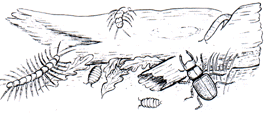Where do Minibeasts Live?
Minibeasts can be found in almost every part of the world. The insects and arachnids have waterproof exoskeletons which reduce water loss from their bodies, enabling them to live in the driest of ecosystems such as deserts. In Britain, large numbers of invertebrates are found in the community of every main habitat – rivers, ponds, lakes, marshes, heathlands, grasslands, woodlands, hedgerows, seashores – as well as people’s gardens and buildings.
 Micro-habitats are parts of larger habitats. A log is an example of a micro-habitat and many minibeasts may be found living underneath it. The log may, however, be in a wood or a garden in which a larger community lives.
Micro-habitats are parts of larger habitats. A log is an example of a micro-habitat and many minibeasts may be found living underneath it. The log may, however, be in a wood or a garden in which a larger community lives.
Other micro-habitats providing suitable homes for invertebrates are stones, bushes, trees, grass, flowers, soil and leaf litter (dead leaves on the ground).
HABITAT – the non-living surroundings (environment) in which an animal or plant lives. All the animals and plants in the habitat make up the COMMUNITY and they are specially adapted for coping with the conditions in the habitat, such as the type of soil, the water, the air and the temperature. So a woodland is the habitat of a stag beetle and a pond is the habitat of a diving beetle.
ECOSYSTEM – a community of plants and animals interacting with one another, plus the habitat in which they live and with which they also interact.
ECOSYSTEM = HABITAT + COMMUNITY
If you study the way in which animals and plants live with one another and with their environment, you are studying the balance of nature – or ECOLOGY.
Read More: What do Minibeasts Eat?